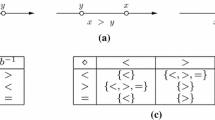Abstract
We describe a restriction of Dechter, Meiri and Pearl's TCSPs (Temporal Constraint Satisfaction Problems) sufficiently expressive to represent any job shop scheduling problem. A solver based on the restriction is then described, which is similar to Ladkin and Reinefeld's qualitative interval network solver; except, however, that the filtering method used during the search is not path consistency but either ULT (Upper-Lower Tightening) or LPC (Loose Path- Consistency), which are both less effective but have the advantage of getting rid of the so-called “fragmentation problem”.
Similar content being viewed by others
References
J F Allen. (1983). Maintaining knowledge about temporal intervals. Communications of the ACM 26: 832–843.
J Carlier, P Chrétienne & C Girault. (1984). Modeling scheduling problems with timed Petri nets. Lecture Notes in Computer Science: Advanced Studies in Petri Nets. Springer-Verlag, 1984.
E Davis.(1989). Private communication (cited in [4]).
R Dechter, I Meiri & J Pearl. (1991). Temporal constraint networks. Artificial Intelligence 49: 61–95.
R Dechter. (1992). From local to global consistency. Artificial Intelligence 55: 87–107.
M Dincbas, H Simonis & P van Hentenryck. (1990). Solving large combinatorial problems in logic programming. Journal of Logic Programming 8: 75–93.
E C Freuder. (1978). Synthesizing constraint expressions. Communications of the ACM 21: 958–966.
E C Freuder. (1982). A sufficient condition for backtrack-free search. Journal of the ACM 29: 24–32.
M R Garey & D S Johnson. (1979). Computers and intractability. New York: Freeman.
R M Haralick & G L Elliott. (1980). Increasing tree search efficiency for constraint satisfaction problems. Artificial Intelligence 14: 263–313.
P Ladkin & A Reinefeld. (1992). Effective solution of qualitative constraint problems. Artificial Intelligence 57: 105–124.
A K Mackworth. (1977). Consistency in networks of relations. Artificial Intelligence 8: 99–118.
U Montanari. (1974). Networks of constraints: Fundamental properties and applications to picture processing. Information Sciences 7: 95–132.
N Sadeh, K Sycara & Y Xiong. (1995). Backtracking techniques for the job shop scheduling constraint satisfaction problem. Artificial Intelligence 76: 115–135.
E Schwalb & R Dechter. (1997). Processing disjunctions in temporal constraint networks. Artificial Intelligence 93: 29–61.
Author information
Authors and Affiliations
Rights and permissions
About this article
Cite this article
Belhadji, S., Isli, A. Temporal Constraint Satisfaction Techniques in Job Shop Scheduling Problem Solving. Constraints 3, 203–211 (1998). https://doi.org/10.1023/A:1009777711218
Issue Date:
DOI: https://doi.org/10.1023/A:1009777711218




